Thoughts on Argentina
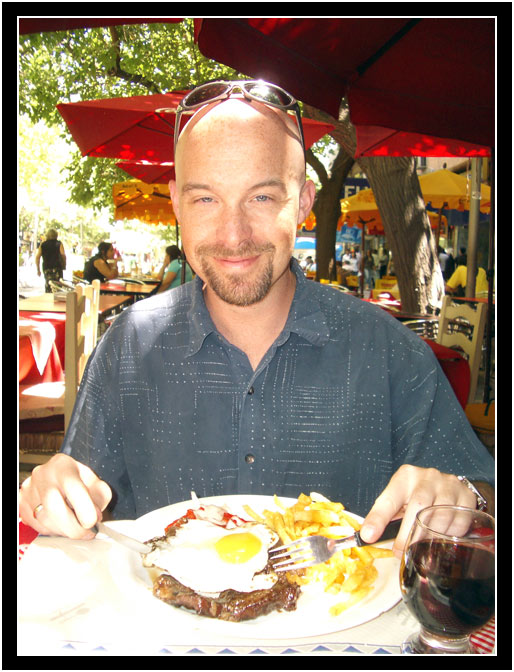
I did an awful lot of traveling last year – so much that I never really had the time to sit down, decompress, and write up some of my thoughts. Driving across the country, Argentina, Peru… part of me wants to put them on my blog in chronological order, but I think it makes more sense to work backwards. Freshest memories to… well, Moleskin notes. In November, Oksana and I spent three week in Argentina. We had the great fortune to have two sets of friends down there, in Buenos Aires and in the country near Córdoba. Surprisingly, we spent most of our time speaking English rather than Spanish. Not that you need to speak Spanish to learn a few things about Argentina. Beef: It’s What’s for Dinner (and Dessert) Argentina loves steak. No, really. You could go the same restaurant for breakfast, lunch, and dinner, order a steak each time, and no one would bat an eye. For a carnivore like me, this is a beautiful thing.

Within hours of landing, we were introduced to our first asado, or, well, BBQ. Not hot dogs and hamburgers – oh no! We’re talking sausages, ribs, and steaks in quantities you couldn’t possibly finish. We were invited to two asados while we were there, once in the big city, and once in the country. They were almost exactly the same. Sausages (regular and blood, or “black pudding”), ribs (beef and pork), followed by thick cuts of beef, and finally the matambre – a thin steak. It seems everyone in Argentina is well-versed in “butcher speak” and knows every cut of meat, but I was forever forgetting the Spanish names for everything. Matambre was easy, however; Mata Hambre… Hunger Killer!
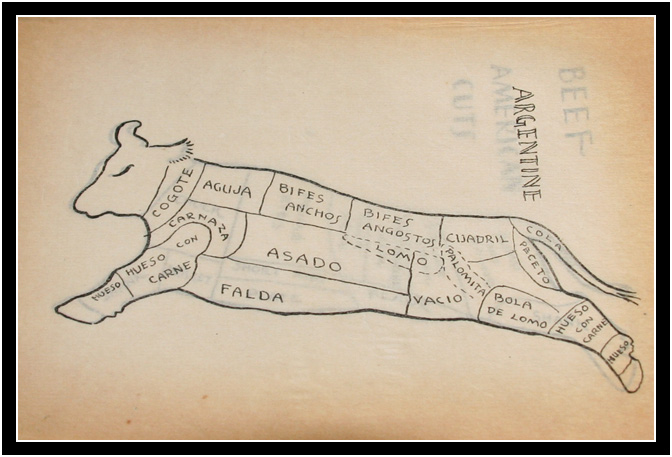
With all that meat at the asado, you might be wondering what the side dishes might be. A glass of wine, maybe a piece of bread. You wouldn’t want to fill up on non-essentials, would you?
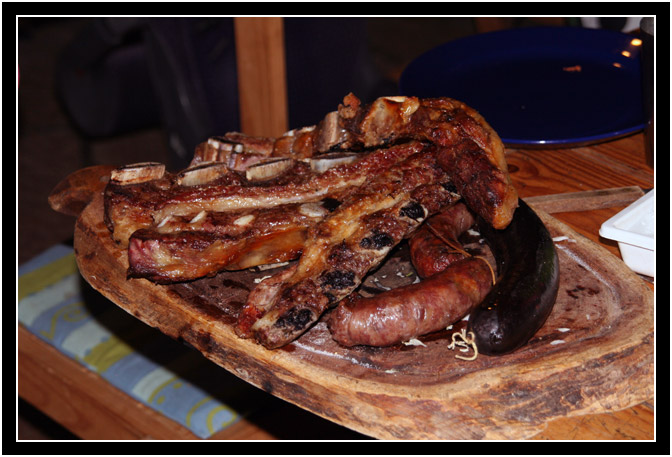
At the restaurants, we sampled other fares. I’ve had lymph nodes before, and they were just as tender as I remembered them. Oksana enjoyed her tongue. Er, the cow’s tongue. You know what I mean. That was as about as adventurous as we got. No sweetbreads or testicles. Oksana and I enjoyed the grills they cooked on, as well. Parrilladasaren’t quite like our backyard BBQs. They’re long metal racks and the charcoal (large, irregular chunks, not briquettes) are heated off to the side. When they’re ready, a small shovel is used to scoop them up and spread them evenly under the rack. Quite smart.
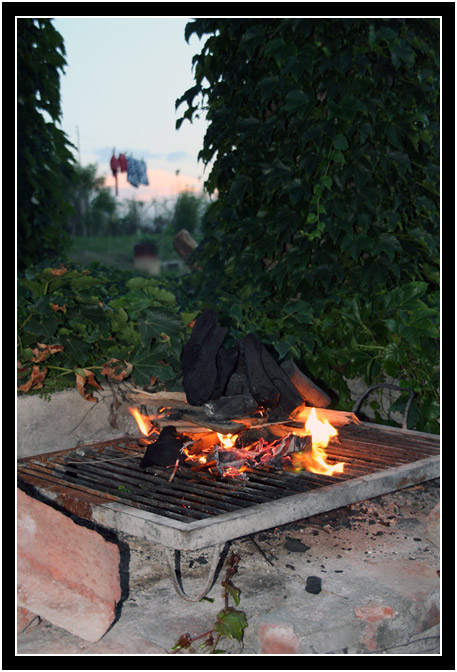
Possibly not unrelated: The stray dogs in Argentina appear to be well-fed. Mate Mate is basically an herbal tea. What’s interesting about it is the way it’s consumed. Everyone in Argentina has their own mate cup. This is always a hollowed-out gourd of some kind, lacquered on the outside, fresh-cut on the inside. Yerba mate, a dried green herb, is dumped in, filling the gourd to the brim. Hot water is poured over and a special metal straw with a sieve in the bottom is used to draw out the tea. To the uninitiated, drinking mate appears to be almost ritualistic. Friends and family share the same gourd and straw, taking endless refills from whoever has the closest thermos. Each person drinks a full gourds-worth of hot water, which may only be two or three sips, before passing it on. We had mate on the commute to Buenos Aires, in the backyard, sunbathing on the riverbank. We thought the story of the taxi driver who perfected the art of pouring his own mate with the crook of his elbow solidified Argentina as the mate capital of the world, but then we heard about the Uruguayan who was spotted pouring his mate as he pedaled by on his bike… Every gas station has a hot water vending machine just for filling mate thermoses. If that doesn’t illustrate how important mate is to Argentinean culture, I don’t know what does. Eggs I have a feeling that Argentineans eat a lot of eggs, but not necessarily for breakfast. We found hard boiled eggs in and on just about everything. Salads, empanadas, pizzas, sandwiches. I once ordered a steak “al caballo” for lunch. I had the vague and admittedly unrealistic worry that I might soon be eating horsemeat, but that was dispelled as soon as the plate arrived. A fried egg was riding the thick slab of steak like a sunny-side up cowboy. Bread Every sandwich we were served in Argentina, every piece of toast, had the crust cut off. Once, when visiting a bakery, I noticed two bakers in the back with a stack of white bread slices, I kid you not, a full meter tall. They were pulling them down, “painting” a thin layer of mayonnaise on each with a large brush, and then adding ham and cheese. The assembly line was justified by the prices posted on the board; one could buy sandwiches by the hundred. I don’t know if there’s a country-wide aversion to bread crust or what, but it’s like every mother in Argentina once cut off the edges and now, no self-respecting sandwich buyer can eat the alternative. Pastries Like most Latin American countries, Argentina has bakeries, or panaderías, that are easy to find. Unlike in other countries, I can’t really say that the bakeries are an ideal stop for breakfast. Oksana and I tried a wide variety of pastries, all of which looked varied and delicious behind the bakery glass. Sadly, after a dozen or so, we noticed a distinct lack of diversity. The dough was the same for all of them and the only difference seemed to be whether or not they included a sticky, sweet glaze or a dollop of marmalade. Didn’t stop us from eating our fair share of medialunas, however. What a descriptive name; just like “croissant!” Alfajores If the pastries were a bit lacking, Argentina redeems itself with alfajores. Alfajores are sandwich cookies, usually dipped in chocolate. There are commercial brands like Havanna and Jorgito that you can buy in every corner store, and there are homemade versions of the same in the bakeries. They come with meals on the airplane and are served for breakfast with coffee on the buses. I understand that different provinces have their own spin on the perfect alfajor. Dulce de leche a dentro, perhaps, or an Oreo-like filling. Oksana and I took a shine to the white hard-glazed version native to Córdoba. Spicy Foods There aren’t any. Pepper to go with your salt? No, it burns. PizzaWhat we thought was a Hawaiian pizza had huge pineapple rings and Maraschino cherries sprinkled over the top. More dessert than dinner.

Straws Sodas are always served with straws. Doesn’t matter if you’re in a restaurant and they give you a Coke in a glass, or if you’re just picking up a can or bottle of Fanta at the bus station. Maybe it’s rude to tip your head back at the table, or perhaps everyone has a crick in their neck. I don’t know, I never asked. EmpanadasYou know how Chinese immigrants sometimes take their cuisine with them when they move to another country? I’ve heard Argentineans take their empanada recipes. There’s nothing quite like a good empanada.
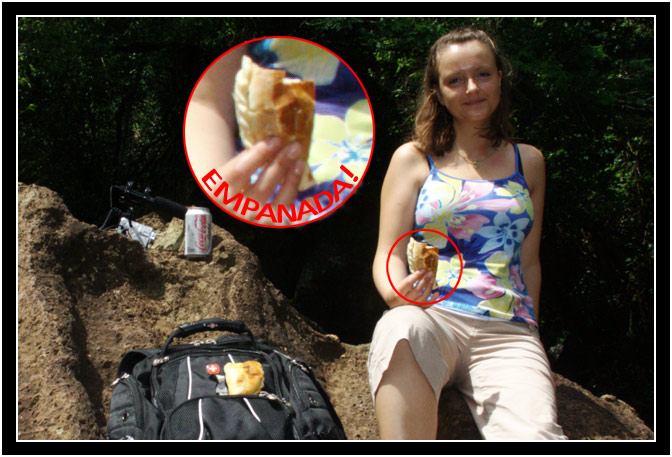
What are they? They’re kind of like Hot Pockets (though infinitely better!) Small, dough-wrapped meat, baked to a flakey-around-the-edges perfection. Usually offered as a snack or appetizer, it’d take at least four or five to make a meal. Contents can be revealed by looking at the pattern of crimping along the edges. Beef, ham, cheese, chicken, onions, eggs, olives, raisins… I could order them blind because there were no bad sabores. They’re the perfect “to go” food; I think I bought more empanadas at bus stations than anywhere else. Busses Speaking of busses… The tourist bus service in Argentina is like nothing I’ve seen before. Better than anywhere I’ve been in Latin America, and certainly better than the few Greyhound trips I’ve been on in the U.S. They’re comfortable, punctual, and dare I say, nigh-enjoyable. We were told before we got to the country there that bussing was the best way to travel. “Visiting us is easy – just hop on a bus in Buenos Aires at 11pm, go to sleep, and you’ll wake up the next morning, fully rested in Córdoba!” We had our doubts. Our first bus experience was a long trip from Iguazú to Córdoba. For some reason neither Oksana nor I can explain, we both had it in our heads that the trip would only be about 12 hours long. (Probably all that talk of restful overnight rides.) We were about four hours into the trip when we realized it was going to be closer to 23. It’s a testament to the bus’s comfort and service that the oversight didn’t much bother us. We had paid a bit extra for semi-cama seats (literally “partial-bed,” or as we thought of it, “a decent recline”) with servicio ejecutivo, or “executive service.” Worth every penny. Oksana and I had spacious seats with more than enough leg room to accommodate both our appendages and our daypacks. Next to us was a hot and cold water dispenser. Ahead, at the front of the bus, was a bright bathroom vacancy light along with a clock and outdoor temperature gauge. We settled in with our iPods and our books and watched the jungle slide by.
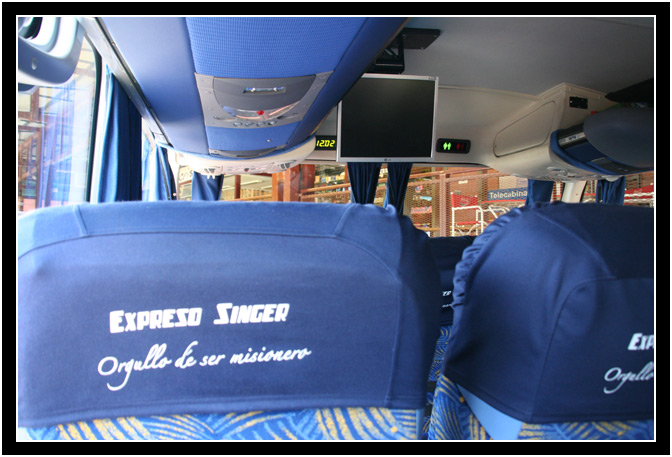
Our bus driver was dressed up like a pilot and our attendant like a maître d’. Periodically, the latter would appear in the aisle with snacks (cookies and soda, perhaps some empanadas and mints.) LCD screens recessed in the ceiling swiveled down and preceded to air movies (The Bank Job, The Mummy III, Starship Dave) at surprisingly reasonable volumes. Late at night (for us; Argentineans are used to it) dinner was served. It was about what you’d expect – microwaved, lots of individually wrapped containers on a big tray – but it was good! There was steak, potatoes, bread sticks and a dinner roll, ham and cheese slices, a piece of cake for desert, and the kicker: A healthy glass of wine. With a refill. And then, after dinner, a champagne nightcap. Really, by the time they came back through to collect the trays around 12:30am, we were more than ready to go to sleep! Here’s the amazing thing: Despite unexpected passport checks at province crossings (with drug dogs) that lasted upwards of 45 minutes, and despite driving 1,500 kilometers over 23 hours, we still arrived en punto, within 5 minutes of our scheduled arrival time. Every tourist bus was as punctual as a Swiss train and I couldn’t figure it out until I awoke early on our final ride back to Buenos Aires. After passing through a toll both on the outskirts of the city, we pulled over to the side of the road. At first, I thought it was another inspection, but I think it was actually the driver letting some time run off the clock. Every bus we ever took arrived at the terminal just 15 minutes before its scheduled departure. Also – and this really impressed me, too – just about every bus station had wi-fi. On longer trips, we had just enough time to pull up our e-mail while picking up new passengers. Later, once we figured out all the ins and outs, we upgraded our tickets to cama total. With seats that converted into horizontal beds, we almost looked forward to long trips across the country. The Classic Project Almost every attendant on every bus would throw in at least one Classic Project DVD sometime on the bus ride. It’s a fascinating compilation of music videos. At first, you think it’s just that, one music video after another. But then you start to pay attention and realize they’re only playing the choruses… and yet each song seamlessly blends into the next. It was hypnotic; I couldn’t pull my eyes away. It also made me realize just how generic a lot of rock music really is. You can see pieces of the Classic Project strewn across Youtube. DrivingLike just about every other Latin American country I’ve visited, Argentina has pretty scary driving conditions. Compared with city driving in the U.S., for instance, the cars in Buenos Aires don’t appear to follow any set rules. Six-lane thoroughfares with clearly marked dividing lines become nine lanes of squeezed together traffic. Right-of-way always goes to the driver with the most guts. And, of course, whenever traffic opens up, speed limits are a personal choice. That said, there’s a world of difference between, say, Argentina and Peru. Where Peruvians seemed more reckless, Argentineans keep their cars mostly dent-free. Also, people in Argentina understand what the car horn is used for – emergency warnings. I wouldn’t have even picked up on this little fact if we hadn’t been sitting in a car at a stoplight on the Obelisk. 500 cars, 12 lanes of traffic going into a traffic circle, and not a single impatient horn to be heard. If the Catholic church is looking for miracles…
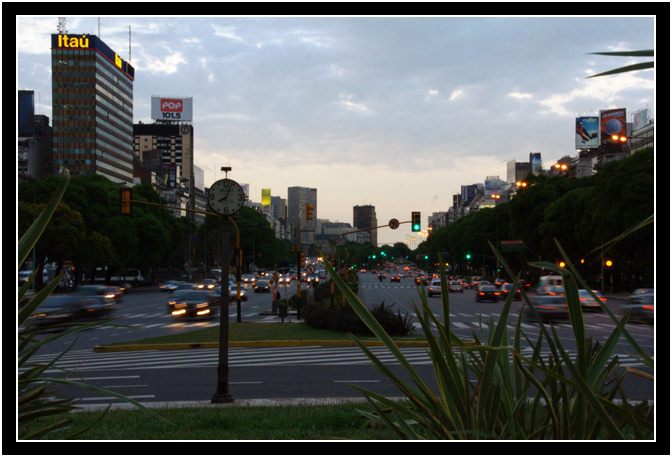
Traffic Lights In Argentina, the stoplights use the following pattern: Green Yellow Red… …Yellow Green This lets everyone waiting at a red light know that a green is coming soon. Now… I’m not sure, but it seems like this might be a little dangerous. Unless the second yellow only turns on after the perpendicular traffic light goes red. If that’s the case, you could argue it’s a better system than what we have in the U.S. (Which amounts to trying to grab an edge-on peek at the other lights.) Selling Your Car Want to sell your car in the States, what do you do? Run out and buy a “For Sale by Owner” sign and put it on your window, right? In Argentina, they place a water bottle on the roof. I didn’t realize what was going on until I mentioned to Oksana, “Ha! That bottle’s been there since yesterday!” One of our friends overheard and told us it was a ‘for sale’ sign. No idea what the next step would be for interested buyers. Grab the bottle and ask around? Movie Theaters Our friends in Argentina took Oksana and me out to see a movie (The Quantum of Solace) at the upscale Village Cines in Recoleta. We bought our popcorn, our candy, our sodas, and followed our friends into the theater. We were early; there wasn’t another person in there. Just before the inevitable previews came on, other patrons began to trickle in. With every other empty seat to choose from, a cute girl came right over and sat next to me. I didn’t think too much of it until I noticed that as more people came in, they all clustered right around us in the middle of the theater. “Neat,” I thought. “It’s like Argentineans have some sort of latent clustering instinct!” Instead of being spread out all through the cavernous room, we’re herded together in the dark, taking solace in our proximity, and enjoying the movie as one. Later, Oksana and I went to another movie (Burn After Reading), and it was then that I realized that they just sold assigned seats. Nevermind. The Look I gave up on blending into any Latin American country a long time ago. Too white, badly accented Spanish, carrying around a camera – when I’m south of the border, I’m a tourist and there’s no hiding it. Most of the time I don’t even care that the shorts and sandals I wear makes me look goofy next to the average Hispanic male. This time, however, we were staying with friends, and I didn’t want to embarrass them. I packed shorts, of course, but I expected to only pull them out when Oksana and I were on our own. First day, after our celebratory arrival asado, our hosts decided to take us into Buenos Aires for a little tour. The two men in the group were still dressed in what I thought of as their backyard BBQ duds – that is to say, decidedly American shorts and t-shirts. When it was time to go, I wondered if they were going to wear the same clothes into town, but I wasn’t going to ask that question. Instead, I simply asked what I should wear. “Oh, put on a pair of shorts!” they replied. “It’s much too hot for pants!” A long anecdote to illustrate something that I soon picked up on: Argentina doesn’t look that much like other Latin American countries (at least not in the big city.) The European influence is very strong and, I have to say, I think I could blend in there… at least until I opened my mouth. The European influence on the gene pool has lightened up the skin color of the average Argentinean to the point where you’d be hard pressed to spot a pure indigenous look any more. While that made it easier for me to blend in, it’s not something I like to spend a lot of time thinking about. High Society Ten years ago, when I was just starting to learn Spanish at the university, I bought a few CDs to listen to. One was by Andres Calamaro, an Argentinean musician, and it was called Alta Suciedad or High Society. So, I knew from way back that there was a bit of a socioeconomic divide in the country. What surprised me was how apparent it would be, even to an outsider. We came into the country right when “the crisis,” the world economic meltdown, was beginning to headline. Labor parties were rallying the street, radio hosts were commenting on retirement funds, and we were trying to make sense of it all. Oksana and I had very interesting conversations with the friends we stayed with and we were fortunate to hear both sides of the argument. I found it all fascinating. It was obvious that there was a strong divide between the upper and lower classes, but there was an equally strong division between the city and country (or, perhaps more accurately, between Buenos Aires and everyone else.) All sides, however, agreed on one thing, and they were very open about expressing it: The government is corrupt. I asked questions on both sides of the fence and, I have to say, couldn’t decide with which side to align my opinion. For example, take the hotbed issue that was going around: What to do with the money in the country’s retirement accounts. Some background (as I understood it): Public workers’ retirement accounts had been handled by 3rd party investment firms. When the crisis hit, the accounts took a hit, and people were worried about their future. The government wanted to take back the accounts because they needed to reassign those assets to shore up the economy. They promised to pay it back. Problem is, a person of my age has already lived through three full economic crashes in Argentina. No one has much faith in that the government is going to see them through this one. The “high society” argument was to keep the retirement accounts in the hands of more trustworthy multinational corporations. Seems smart enough, considering. The “low society” argument was that, because the government had allowed the corporations certain loopholes, there was no guarantee that they wouldn’t leave the country with all their money, anyway. In that case, the best bet was to have the government take control of the funds because at least they could be trusted to provide a retiree with at least a minimum of funds to live on. (Granted, it might take a lot of pressure from the citizens to enforce that, but again, at least they had somesway over the government. What influence do angry citizens have on a corporation that isn’t even in Argentina?) Both sides had valid arguments; I found myself unable to pick a side. It left me with a feeling of futility. I can’t imagine what it would feel like to live there. Some of the other issues that came up in the conversations we had were equally frustrating. I remember thinking the influence certain labor unions had was frightening and economically unhealthy. I remember long talks in which I learned about the constitutional laws and rights Argentina lived with. While they were strikingly similar to our own constitutional laws, the problem seemed to be that no one really paid them much heed. In a corrupt government, there are always ways to use money or influence to skirt around pesky laws. For example, consider that everyone knows and accepts that one can bribe their way out of a speeding ticket. Therefore, everyone speeds. Apply that attitude to every law, at every level of government, and you can see why neither the high nor low society has any faith in their government.

The Argentinean Accent Long before my first trip to Argentina, I knew about the accent. The double-L “jzh” sounds, using vos in place of tú, things like that. While I doubt I’ll ever have an ear for vos, there are certain words I learned from my Conversational Spanish instructor that’ll always have that Argentinean flair: Bajzhena (whale), for instance. What I didn’t realize is that the Argentinean accent varies greatly throughout the country. Even my tin ear could pick up the difference between the Buenos Aires “sh” and the more rural “jzh” sounds. Me shamo José. Me jzhamo José. I waited too long to write these thoughts up; I’m sure I’ve forgotten some good colloquialisms. It’s hard to miss how they all say goodbye, though: The distinctly Italian Chao! Also, everyone says “dale.” Hard to nail down exactly what it meant, because it was used in different ways (and about every third sentence), but I think it generally meant “let’s go,” “do it,” or “come on.” Time Argentina isn’t just in a different time zone, they’re on a different schedule altogether. For instance, dinner doesn’t generally start until after 10pm and sitting down to eat any earlier than 9pm is a bit peculiar. It wasn’t uncommon to find ourselves finishing dinner with our friends after midnight. Of course, this has a lot to do with The Siesta. I was talking to a girl in Córdoba who was telling me that parents drill their children to “respect the siesta!” By that she meant, socially, it wasn’t acceptable to keeping working through the afternoon and, further, that not only should everyone take a break, they should also take a nap! Oh, to live in a culture like that! Of course, the siesta has repercussions that extend through the night, ’til the sun comes up, in fact. Whereas here, in the U.S., a club might not get hopping until around 11pm, in Argentina, they’re dead until at least 2 or 3am. Weekend parties always last until the sun comes up. I swear, it’d take me at least a year to become accustomed to that. WineOh, man, did I not write enough about the wine? We brought 13 bottles home with us.
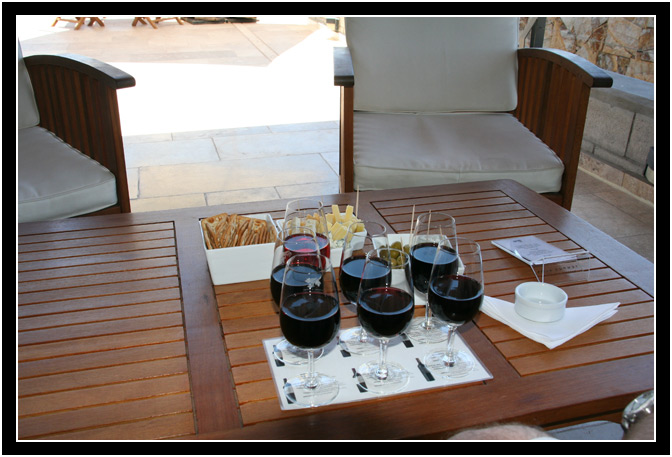

I like the movie theater story. I wonder if you ended up sitting in someone’s assigned seat the first time around.
I don’t think we sat in the wrong seats, if only because our friends from Buenos Aires led us to them. See, we wanted to treat them to a movie, but they had us meet up with them at the theater… after they had already bought the tickets. Thwarted! (We convinced them to let us buy dinner afterwards, though.)
Well written. Thank you. Great smattering of info… I found it Googling “Bus cordoba iguazu.” I’m going in November. Will take bus to Cordoba, drive around a lot in a rental car, bus to Iguazu then bus to BA…. hope that’s realistic…
Definately will spend the extra $5 us to get full cama….
Best,
Chris.
Thanks, Chris. I think your plan sounds okay, as long as you’re comfortable with the travel times. We flew from BsAs to Iguazu, so I couldn’t tell you how long that leg of the trip’s going to be. Our flight wasn’t long, however, and I remember thinking it was worth the price. Still, the buses are quite good.
Don’t know if you saw them, but we posted a couple Iguazu videos, too, starting with http://blog.arlomidgett.com/2009/08/10/pv002-iguazu-argentina/ You’re going to love it there!
Arlo:
Thanks for the reply!
Mind if I mine your knowledge more? My new plan at this point (given the
24 hour bus rides) would to take a Bus to Cordoba, rent a car… drive
around the area, to Mendoza, and up the Andes trail (I’ve driven a Toyota
Yaris over the passes in Peru to Cusco, foolishly fording rivers so I hope
I can manage the treacherous Andes crossing)… return to Cordoba, fly to
Iguazu then fly back to BA.
I’m having a hell of a time trying to book the flight though… and price
differentials seem all over the chart… I understand as a Muzungu I have
to pay more, but booking seems an insurmountable challenge!
Any thoughts you have would be really appreciated..
Chris.
p.s. I loved the trip video which was really well put together – nicely
tied in to the music beats, and I’m going to make the recepie for beets n’
veggie soup….
*************************************
Hi again, Chris.
Sure, happy to try to answer some more questions.
Sounds like a good plan, substituting the flights for the longer bus rides. I should point out, however, that just about any bus ride that lasts 12 hours or less will be an overnight trip. With a traditional bus, you could consider that
a lost day of travel because you’d probably just get to your destination and crash — but with the super-cama buses of Argentina, I had no problem sleeping through the night and arriving quite rested. Still, no getting around losing
an entire day with those 24 hour bus rides!
We only booked one internal flight in Argentina and we booked it while we were there. Quite a painless process,really. There’s a very touristy street in BsAs — I want to say it’s “Florida Street” — where they have all sorts of
services catering to our foreign needs. We walked right into the airlines office and booked our tickets at the counter. (I remember it being the first real test of my Spanish, but I wasn’t worried because I realized I had a safety
net when I overheard other agents speaking English.)
So, that’s my suggestion. Wait until you get there to buy your airlines tickets. You may still end up paying tourist prices, but at least you won’t be hit with a travel agent surcharge as well! Worst case scenario, you take the bus
trip you were originally planning, right?
Oh, also: I haven’t been ballsy enough to rent a car in a foreign country yet, but I would think that getting one in Cordoba/Mendoza would be fine. Cordoba is somewhat chaotic, but the roads between the cities a great — good infrastructure and quite scenic. Buenos Aires is crazy, though, especially around el obalisco. You should get a medal if you drive through there.
And, DAMN, you drove a Yaris over the Cusco passes? Did they look like this:
http://peru.arlomidgett.com/2009/07/17/roughcut-16-the-road/
http://peru.arlomidgett.com/2009/07/22/roughcut-17-driving-back/
http://peru.arlomidgett.com/2009/05/20/roughcut-01-mudslide/
Where did you go? We took a trip to the Manú Preserve and I wouldn’t have bet a dollar that a Yaris could make
the trip. Toyota should get your testimonial and use it in a commercial or something!
-A.
********************************
Arlo –
Thanks for the thoughts. I’ll do that – which is what I usually do – figger it all out when you get there….
As for the Yaris, yes – that’s what it was like… the crazy part was fording a massive river that ran over the road (because the main road was under construction). I waited and watched the large tour buses ford it, watched the 4×4 pickups ford it, figured where it was least deep, popped the car into 2nd gear, got a head start and just plowed through… that was nuts..
But perhaps more nuts was the drive from Puno to Arequipa. They were building a new paved road, so we had to take back roads through the desert, but we got hopelessly lost, driving 10 mph because the road was so bad, had to ford more really scary rivers, and finally in the middle of stock ass no-where some ancient guy wanted a ride. HOP IN! Show us how to get out of here was all we could think… Made it into town very late at night, completely frazzled…
But you should absolutely not shy away from driving. I’ve driven through the mountains of Guatemala, muddy forest roads in Belize, hill passes in Israel, and Egypt, but the nuttiest driving I ever experienced was in Italy. Ei! Roads 1/2 the size of the 2 cars trying to pass each other…
When you have your own car the world is so completely different. You stop where you want, you stay till the parks close and watch the sun drift down over Tikal or wherever you are… there’s absolutely no other way to see a country… Of course, you’ll need all your guide books to teach yourself the sites, but its well worth it… My favorite memories are of stopping in the country, slipping the cork of a very cheap wine, and eating some fruit, cheese and other goodies from a local market, lying back on the grass in the sun just absorbing the earth, trees, breeze. Time just stops.
Great talking to you Arlo,
Chris.
So I finally planned it –
We’re going to rent a small car in BA, drive to Cordoba then Mendoza, drive the pass to Chile (for a $100 fee with the rental company – remember to book in advance!), drive up the Chile coast, then drive over the Agua Negra pass… (OK I’ve seen the photos, it looks easier than the pass to Cusco in Peru! We can do it!), from there to La Rioja, and from there see where we are. If we have time, drive like bandits to Iguazu, stay a couple of days then drive like bandits to BA….
This will be our longest trip yet (in KM….)… Guatemala, Italy and Spain were around 2500km in 2 weeks… this will be 5000 km in 2 weeks, but a few really really long legs…
Wish us luck!
Chris.
Wow, sounds like quite a lot of driving, Chris. Hope you’ve got a lot of good road tunes loaded up on your iPod. 🙂
When are you going to be doing this trip? Not that it really matters now, but I was going to be in Chile from around mid-December to mid-January. Destination got changed, though, and we’re headed for Ecuador instead.
My wife and I are actually in route to Puerto Rico right now. Sounds like the best way to get around the island is to rent a car, so who knows? Maybe this will be my first baby steps to driving in a foreign country.
Good luck on your trip, and let me know how it turns out!